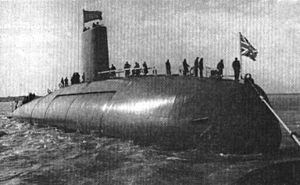HMS Dreadnought (S101)
 |
|
| History | |
|---|---|
|
|
|
| Name: | HMS Dreadnought |
| Builder: | Vickers Armstrongs, Barrow-in-Furness |
| Laid down: | 12 June 1959 |
| Launched: | 21 October 1960 |
| Commissioned: | 17 April 1963 |
| Decommissioned: | 1980 |
| Identification: | Pennant number: S101 |
| Fate: | Laid up at Rosyth Dockyard |
| Badge: |  |
| General characteristics | |
| Class and type: | Nuclear-powered submarine |
| Displacement: | |
| Length: | 265.7 ft (81.0 m) |
| Beam: | 31.2 ft (9.5 m) |
| Draught: | 25.9 ft (7.9 m) |
| Propulsion: | 1 x Westinghouse S5W reactor, two geared steam turbines, one shaft, 15,000 shp (11,000 kW) |
| Speed: | 20 knots (37 km/h; 23 mph) surfaced; 28 knots (52 km/h; 32 mph) submerged |
| Complement: | 113 |
| Armament: | 6 x bow tubes for 21 in (530 mm) torpedoes, 24 rounds carried |
The seventh HMS Dreadnought was the United Kingdom's first nuclear-powered submarine, built by Vickers Armstrongs at Barrow-in-Furness. Launched by Queen Elizabeth II on Trafalgar Day 1960 and commissioned into service with the Royal Navy in April 1963, she continued in service until 1980. The submarine was powered by a S5W reactor, a design made available as a direct result of the 1958 US–UK Mutual Defence Agreement.
The Royal Navy had been researching designs for nuclear propulsion plants since 1946, but this work was suspended indefinitely in October 1952. In 1955 the United States Navy completed USS Nautilus, the world's first nuclear-powered submarine. During subsequent exercises with the Royal Navy, Nautilus demonstrated the advantages of the nuclear submarine against British anti-submarine forces, which had developed extensive anti-submarine warfare techniques during the Battle of the Atlantic. The Admiralty appreciated the utility of such vessels and under the drive of the First Sea Lord, Admiral The Earl Mountbatten of Burma and the Flag Officer Submarines, Sir Wilfred Woods, plans were formed to build nuclear-powered submarines.
Although the plan was to build all-British nuclear submarines, much time would be saved by accepting US nuclear technology. The excellent relations between Admiral Mountbatten and US Navy Chief of Naval Operations Arleigh Burke, expedited obtaining that help. This was despite Rear Admiral Hyman Rickover, in charge of the American naval nuclear power program, being set against any transfer of technology; indeed, Rickover prevented Mountbatten inspecting USS Nautilus. It was not until a visit to Britain in 1956 that Rickover changed his mind and withdrew his objections. Although Rickover wished to supply the third generation S3W reactor of the Skate class, Mountbatten exerted his influence and the entire machinery system for an American Skipjack-class submarine, with its fifth generation S5W reactor, was obtained. This was known as the "American Sector" (see 1958 US-UK Mutual Defence Agreement). The hull and combat systems of Dreadnought were of British design and construction, although British access to the Electric Boat Company influenced the hull form and construction practices.
...
Wikipedia
